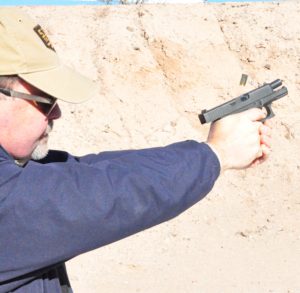 I just returned from my annual sojourn to Las Vegas to attend the SHOT Show (Shooting Hunting and Outdoor Technology–at best, a tortured acronym), which is sponsored by the National Shooting Sports Foundation. The SHOT Show is to shooting and archery what the Detroit Auto Show is for car manufacturers, the event when new products are launched. It’s also an opportunity for me to meet with my subject matter experts face-to-face. A highlight of the SHOT Show is Media Day at the Range, when folks like me can shoot a wide variety of weapons, while sending hundreds of rounds of free ammo downrange.
I just returned from my annual sojourn to Las Vegas to attend the SHOT Show (Shooting Hunting and Outdoor Technology–at best, a tortured acronym), which is sponsored by the National Shooting Sports Foundation. The SHOT Show is to shooting and archery what the Detroit Auto Show is for car manufacturers, the event when new products are launched. It’s also an opportunity for me to meet with my subject matter experts face-to-face. A highlight of the SHOT Show is Media Day at the Range, when folks like me can shoot a wide variety of weapons, while sending hundreds of rounds of free ammo downrange.
As I wandered the 17 miles (!) of display aisles, it occurred to me that the average writer–or person, for that matter–cannot comprehend the thousands of variations that exist for what we casually call a gun. In this post, I thought I’d walk you through some of the major decisions your character would consider in deciding which firearm to carry.
Revolver, Pistol, or . . . Something Different?
For we gun porn purists, pistols and revolvers ar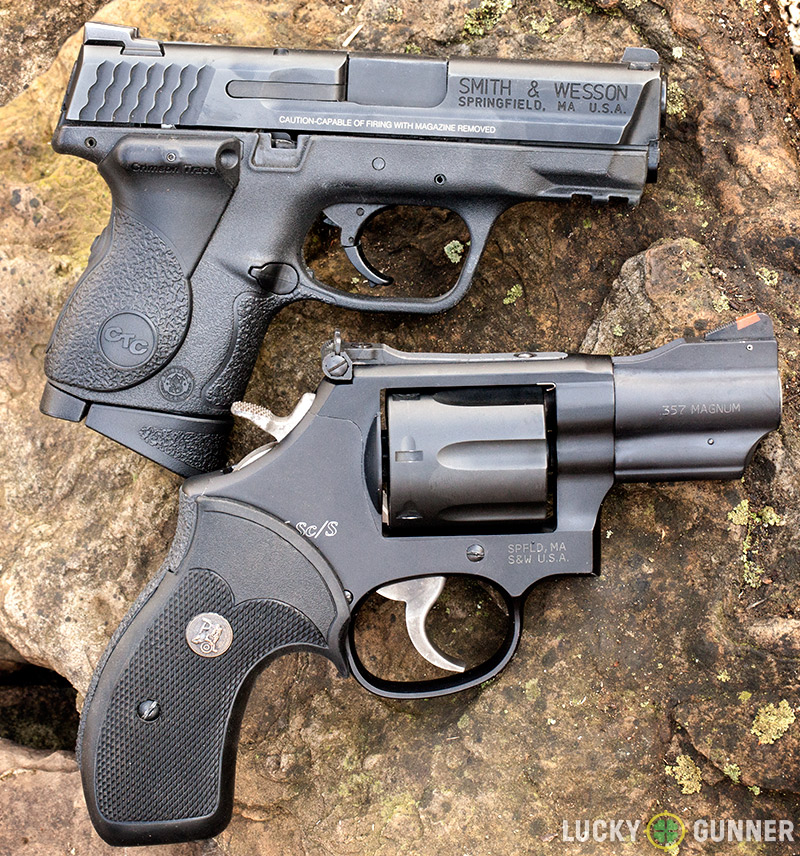 e mutually exclusive. Both are handguns, but they operate under entirely different principles. A revolver, otherwise known as a “wheel gun”, holds its cartridges in a cylinder that rotates as the hammer comes back and prepares for each shot. The revolver in the picture features an external hammer, and can be fired double action (DA) or single action (SA), which makes it a DA/SA revolver. (Double action means that with the hammer down, a single pull of the trigger with bring the hammer back, rotate the cylinder, and then drop the hammer again, firing the gun. Single action would describe the condition where the hammer is manually cocked and remains back–“condition zero”. From this condition, the trigger is more sensitive by a large margin.) Generally, there are no external safeties on a revolver. The fact of the long DA trigger pull functions as a safety. Only a fool would carry a revolver in condition zero.
e mutually exclusive. Both are handguns, but they operate under entirely different principles. A revolver, otherwise known as a “wheel gun”, holds its cartridges in a cylinder that rotates as the hammer comes back and prepares for each shot. The revolver in the picture features an external hammer, and can be fired double action (DA) or single action (SA), which makes it a DA/SA revolver. (Double action means that with the hammer down, a single pull of the trigger with bring the hammer back, rotate the cylinder, and then drop the hammer again, firing the gun. Single action would describe the condition where the hammer is manually cocked and remains back–“condition zero”. From this condition, the trigger is more sensitive by a large margin.) Generally, there are no external safeties on a revolver. The fact of the long DA trigger pull functions as a safety. Only a fool would carry a revolver in condition zero.
Recent years have seen a growth in the popularity of the DAO (double action only) revolver. With no external hammer to cock, every pull of the trigger is double action. The upside of a hammerless revolver is the ease of the draw from concealment (hammers have a way of snagging on clothing).
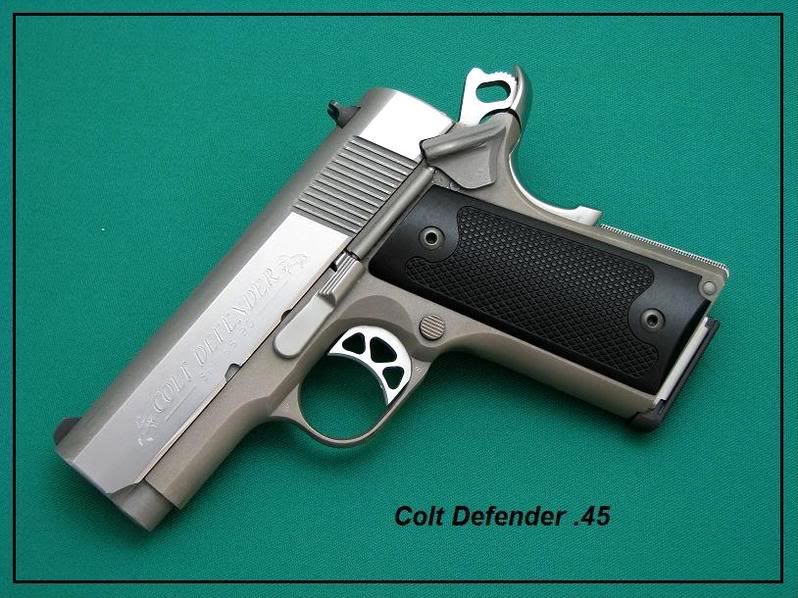 A pistol, on the other hand, carries its load in a magazine that is inserted in the grip. As the weapon fires, the slide cycles, ejecting the spent shell casing and pushing the next round into battery. The picture at the top of this post of me at the range shows this cycling action of a Glock 36 at 1/4000 of a second–thanks to my son, Chris, for getting the picture.
A pistol, on the other hand, carries its load in a magazine that is inserted in the grip. As the weapon fires, the slide cycles, ejecting the spent shell casing and pushing the next round into battery. The picture at the top of this post of me at the range shows this cycling action of a Glock 36 at 1/4000 of a second–thanks to my son, Chris, for getting the picture.  The pistol in the picture with the revolver has no hammer, but is rather “striker fired”–a distinction that is best left to a future post. Striker fired pistols may or may not have external safeties. Some pistols have external hammers, such as the Colt Defender in the picture. As shown, the Colt is in condition one, which means cartridge in the chamber, hammer back and safety on–otherwise known as “cocked and locked.” In yet another iteration, many manufacturers make DA/SA pistols. The Bersa Thunder in the photo offers a very long, hard DA trigger pull for the first shot, which leaves the hammer back for a SA follow-up shot. For most DA/SA pistols, the “safety” is not a safety at all, but rather a de-cocker, which safely returns the hammer to its DA position.
The pistol in the picture with the revolver has no hammer, but is rather “striker fired”–a distinction that is best left to a future post. Striker fired pistols may or may not have external safeties. Some pistols have external hammers, such as the Colt Defender in the picture. As shown, the Colt is in condition one, which means cartridge in the chamber, hammer back and safety on–otherwise known as “cocked and locked.” In yet another iteration, many manufacturers make DA/SA pistols. The Bersa Thunder in the photo offers a very long, hard DA trigger pull for the first shot, which leaves the hammer back for a SA follow-up shot. For most DA/SA pistols, the “safety” is not a safety at all, but rather a de-cocker, which safely returns the hammer to its DA position.
What difference does it make?
There are so many variables, but consider just a few:
- If your character is going to shoot through a pocket or a purse, a revolver is the better choice because a pistol’s slide would likely get fouled or tangled in fabric, making a follow-up shot difficult if not impossible.
- It’s much more cumbersome and time consuming to reload a revolver.
- No modern revolver I can think of is compatible with a suppressor.
- For less-experienced shooters, a DA/SA revolver is generally a better choice.
What Caliber?
I’ve discussed bullet choices here in TKZ before, so I won’t regurgitate all of that here, but it is definitely a consideration. If your character is a cop or in the military, chances are that s/he won’t carry anything smaller than 9mm. On the flip side, I don’t know anyone who carries the Harry Callahan .44 magnum (“the most powerful handgun in the world and will blow your head cleeean off), but I know lots of people who carry .45 or .357 magnum.
Where on their bodies do they carry the gun?
 If your character is an on-duty cop or active duty military, where sidearms are worn in some kind of duty rig, the sky’s the limit for what they want to carry. You can buy holsters for all kinds of hand cannons. The choices become more limited when it’s important for your character to conceal his or her weapon. As a general rule, the larger the firearm, the harder it is to conceal. The obvious corollary is that bigger people can conceal bigger guns.
If your character is an on-duty cop or active duty military, where sidearms are worn in some kind of duty rig, the sky’s the limit for what they want to carry. You can buy holsters for all kinds of hand cannons. The choices become more limited when it’s important for your character to conceal his or her weapon. As a general rule, the larger the firearm, the harder it is to conceal. The obvious corollary is that bigger people can conceal bigger guns.
 When it comes to carrying a gun on one’s belt, the critical first choice is inside-the-waistband (IWB) vs. outside-the-waistband (OWB), and both mean exactly what the words say. Generally, OWB carry is more detectable,
When it comes to carrying a gun on one’s belt, the critical first choice is inside-the-waistband (IWB) vs. outside-the-waistband (OWB), and both mean exactly what the words say. Generally, OWB carry is more detectable, 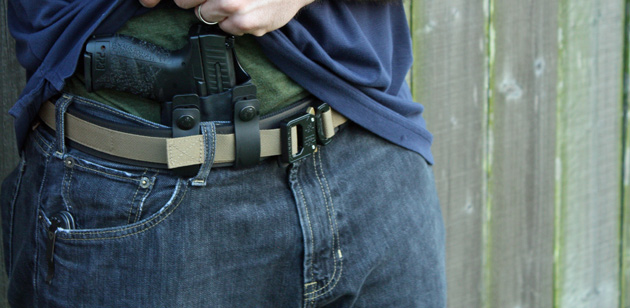 but with the right holster and an effective cover garment, it can be very effective. By contrast, IWB carry allows for concealment by means as simple as an untucked T-shirt. On the downside, the gun takes up waistband real estate that would otherwise be used by the waist.
but with the right holster and an effective cover garment, it can be very effective. By contrast, IWB carry allows for concealment by means as simple as an untucked T-shirt. On the downside, the gun takes up waistband real estate that would otherwise be used by the waist.  If your character wears skinny jeans, IWB could be a problem. IWB carry positions are referred to as positions on a clock face, where one’s navel would be 12 o’clock and the right hip would be 3 o’clock. The IWB position in the picture is referred to as “appendix carry”, and for the life of me, I don’t know how he would be able to sit down. Shoulder rigs are popular in movies and television shows, but I
If your character wears skinny jeans, IWB could be a problem. IWB carry positions are referred to as positions on a clock face, where one’s navel would be 12 o’clock and the right hip would be 3 o’clock. The IWB position in the picture is referred to as “appendix carry”, and for the life of me, I don’t know how he would be able to sit down. Shoulder rigs are popular in movies and television shows, but I 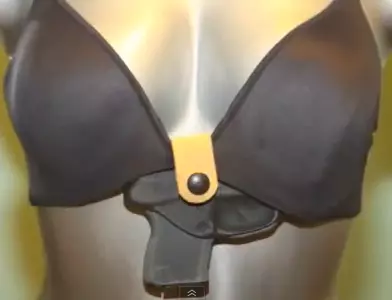 have never met a real person who wore one and didn’t hate it over time. They’re hard on the shoulders, and you can never let your arms hang normally. But the deal breaker for me would be that during the draw stroke, you pretty much have to point the gun at the person behind you, and then subsequently at yourself. That violates the basic tenets of firearm safety–as do many of the specialty retention devices such as the bra holster. ‘Nuff said, can we agree?
have never met a real person who wore one and didn’t hate it over time. They’re hard on the shoulders, and you can never let your arms hang normally. But the deal breaker for me would be that during the draw stroke, you pretty much have to point the gun at the person behind you, and then subsequently at yourself. That violates the basic tenets of firearm safety–as do many of the specialty retention devices such as the bra holster. ‘Nuff said, can we agree?
Now, suppose your character needs to go for deep concealment, and the weapon is merely for close-in defense? Suppose the only concealment option is a vest pocket, or perhaps a boot? Search the Web for specialty guns that are actually well-made and very effective for what they are. North American Arms makes a mini-revolver that easily fits in your fist, and can be chambered in .22 magnum, a round that shows very similar terminal ballistics to a .38 special, un
the only concealment option is a vest pocket, or perhaps a boot? Search the Web for specialty guns that are actually well-made and very effective for what they are. North American Arms makes a mini-revolver that easily fits in your fist, and can be chambered in .22 magnum, a round that shows very similar terminal ballistics to a .38 special, un der ideal circumstances. The tiny, nearly non-existent barrel is a problem for a shot longer than, say, 10 yards, but as a belly gun, it’s kind of impressive, and since it’s a revolver, your character gets five tries to bring justice to another character.
der ideal circumstances. The tiny, nearly non-existent barrel is a problem for a shot longer than, say, 10 yards, but as a belly gun, it’s kind of impressive, and since it’s a revolver, your character gets five tries to bring justice to another character.
The Derringer lives on. Bond Arms manufactures a wide line of two-shot firearms that come chambered in nearly every caliber. One will even take 410 gauge shotgun shells. Beware, however, that there’s a direct trade-off between the weight of a firearm and the degree of felt recoil. These little guns kick like angry horses.
Questions?
At this point, rather than me blathering on answering presumed questions, let’s switch over to the real things. Any particular problems you’re tackling in your WIP?

Love this, John. I particularly like the holster pics & the small guns. I tend to research weapons on gun forum chats or youtube videos to see how they operate or what weapon might fit a woman’s hand, etc. But the visuals here are very helpful. Once I narrow down a weapon, based on what I perceive as my character’s choice, I don’t always think of how they carry it until I get into the story. This is good info. Thank you.
Glad I could help. 🙂
Can you address the difference in sound between some of these weapons? I seem to run into a fair number of books where the main character can guess what weapon the baddie is using based on the sound of the shots, and therefore knows range of the weapon, how to time runs for cover, etc.
Thanks,
Kathy
There is a very distinct difference in sound between a rifle and a pistol, but within those categories, things are a little dicey.
To my ear, there’s a distinct difference between a .22, a .380, and a 9mm or larger. I can’t tell the difference between a 9mm or a .40, .45 or .44 special. When you get to the magnum rounds, there’s another distinct difference, but I would have trouble differentiating between .357 magnum and .44 magnum. The manufacturer of the gun (Colt vs. Smith & Wesson, for example) would have no impact on the sound.
Does that answer your question?
I recently read a book where a lot of this information was thrown at the reader. Understanding everything you’ve presented here is one thing. Dumping it on the reader is a whole ‘nother game.
It can be a difficult balance, for sure. I feel the same way about recipes in books.
Yeah, but it’s easy to skip over recipes, and they’re usually not given in a step by step Food Network demo kind of way, but presented in cookbook fashion. This guy went on for PAGES and only someone such as yourself would have known whether all the detail was accurate. It sure wasn’t needed to move the story forward.
One of the best guys-with-guns authors is Stephen Hunter, but even I glaze over on some his gun porn.
There’s a larger point to be made here, though, and it gets to the basics of writing. Less is almost always more. In describing anything on the page, I try to give the reader just enough detail to visualize the scene and the action, and then I move on. I remember trying to read Michener’s CHESAPEAKE back in the ’70s or ’80s and shouting at the book, “Let him eat the damn crab!” There was an author who loved to hear himself write. The endless descriptive details left me in the dust.
“Less is almost always more. In describing anything on the page, I try to give the reader just enough detail to visualize the scene and the action, and then I move on.”
Exactly! And that just happens to be my topic on my blog tomorrow. 😉
What’s your opinion of using the whole gun name – ie Heckler & Koch (or H&K) UMP submachine gun or Beretta 92FS vs a shorter slang name that gun owners would use?
With my scenes in deep POV with a character who knows his or her weapon, I tend to start with full name before I shorten (if I find a good reference in my research).
You’re a lot more familiar with weapons than I am. I’d like your take.
This touches on what Terry wrote above, vis-a-vis finding the sweet spot. I tend to soft pedal the gun porn in my books (no talk of lands and grooves, bullet weight, etc.), but because they feature a good bit of gun play, I don’t want to leave any readers confused, but I still want to satisfy the significant portion of my audience who grooves on the technical stuff. The first time I mention a weapons platform, I’ll give it a detailed description, but after that I’ll make abbreviated references. For example, a first reference might go something like this:
Jonathan watched as Boxers slung his Heckler & Koch 417, a portable cannon chambered in 7.62 millimeter.
After that, I’ll refer to it as his 417 or his HK417.
Just call it a roscoe and be done with it.
Ah, pulp.
Wow, John, That’s not a post, it’s an encyclopedia (or maybe Wikipedia) article. I’ll save that one for future reference. Thanks for sharing with us.
Thanks, Richard!
Any thoughts about the pros and cons of laser sighted firearms. Do they help or hurt in actual usage? Thanks for an informative discussion, John!
Kathryn, I’m not a fan of lasers on handguns for many reasons, not the least of which is because it’s one more moving part to go wrong. Studies have shown that when shooters train with iron sights, their body mechanics are better, which makes their marksmanship better. There’s a tendency when training with laser sights to concentrate more on the target than on the sights. Given that lasers are useless in bright light, the lack of skills with iron sights could make for a very bad day.
(NOTE: there are many, many people who would disagree with me.)
Ah, interesting thought. I wonder why technology hasn’t come up with an effective way to make it easier to aim reliably. Thanks, John!
It’s called hundreds of hours at the range. Truth be told, aiming is not the problem. The problem is trigger pull (or trigger press as they say these days). people tend to pull their wrist while they press the trigger, or they dip the muzzle in anticipation of recoil. The only way to overcome these tendencies is to practice. A lot. At 10 feet, a mere 1/2 inch of muzzle float will put you 8 inches off your target. That’s why they teach cops and soldiers to shoot at the center of mass, where the margin for error is greater.